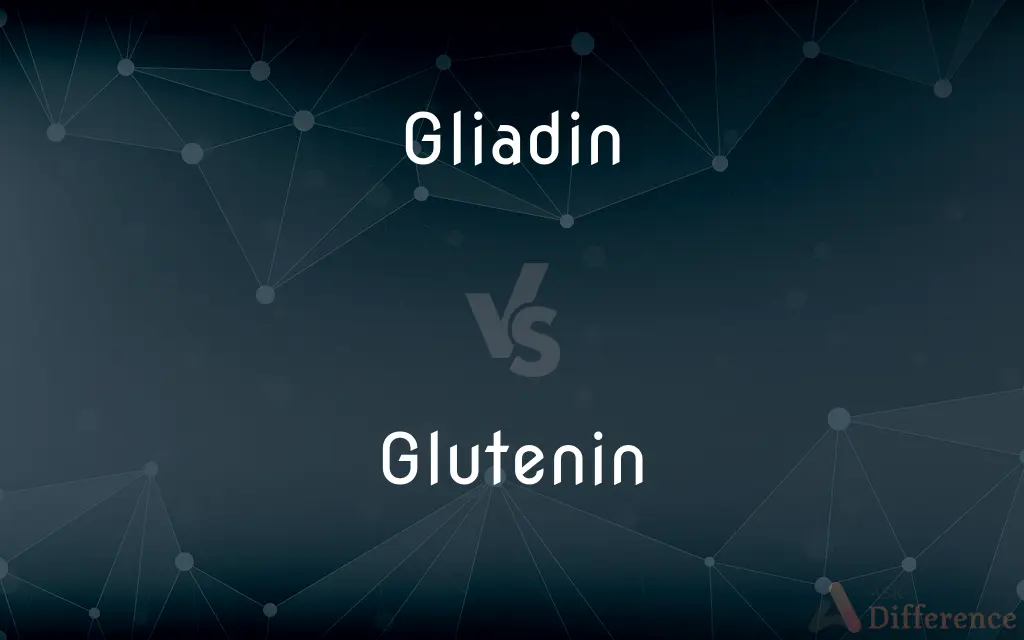Gliadin vs. Glutenin — What's the Difference?
By Fiza Rafique & Maham Liaqat — Updated on March 13, 2024
Gliadin and glutenin are both proteins found in wheat that combine to form gluten, but gliadin is responsible for dough's extensibility and stickiness, while glutenin contributes to its strength and elasticity.

Difference Between Gliadin and Glutenin
Table of Contents
ADVERTISEMENT
Key Differences
Gliadin, a type of prolamin protein found in wheat and some other cereals, plays a crucial role in the baking quality of wheat by making the dough sticky and extensible. It is one of the main components of gluten, alongside glutenin. Glutenin, on the other hand, is a glutelin-type protein that provides dough with its strength and elasticity, essential for the bread's structure and chewiness. While gliadin allows the dough to expand and rise by trapping gas bubbles, glutenin gives the dough its necessary resilience and firmness.
The interaction between gliadin and glutenin during kneading and baking is fundamental to the texture and structure of baked goods. Gliadin's contribution to dough extensibility means that it helps in the spreading and shaping of the dough, whereas glutenin’s elasticity allows the dough to hold its shape and form a firm, structured bread. These proteins, when hydrated and mixed, form a complex network that is the basis of gluten's unique properties.
In terms of health and dietary considerations, it's important to note that gliadin is often implicated in gluten-related disorders, such as celiac disease, due to its immunogenic properties. Glutenin, while also a concern in gluten intolerance, is less frequently discussed in this context. The differences in their biological impacts underscore the complexity of gluten sensitivity and the need for specific research focused on each component.
The production of gluten-free products often involves finding alternatives that can mimic the properties of gliadin and glutenin, a challenging task given their unique contributions to dough properties. Researchers and food scientists work to replicate the stickiness and elasticity provided by these proteins to create satisfactory gluten-free options.
Understanding the distinct roles of gliadin and glutenin is essential for professionals in food science and baking, as manipulating the proportions of these proteins can significantly affect the texture and quality of wheat-based products. Their synergistic relationship is what makes wheat flour particularly valuable in a wide range of culinary applications.
ADVERTISEMENT
Comparison Chart
Protein Type
Prolamin
Glutelin
Role in Dough
Contributes to dough's extensibility and stickiness.
Contributes to dough's strength and elasticity.
Impact on Baking
Allows dough to expand and rise by trapping gas bubbles.
Provides dough with resilience, enabling it to hold shape.
Dietary Concerns
Often implicated in gluten-related disorders due to its immunogenic properties.
Also a concern in gluten intolerance, but less frequently discussed.
Contribution to Gluten
Part of gluten that makes dough sticky and pliable.
Part of gluten that gives dough its firmness and structure.
Compare with Definitions
Gliadin
A protein that makes dough sticky and extensible.
Gliadin's role is crucial for the dough's ability to stretch without breaking.
Glutenin
A protein that gives dough its elasticity.
Glutenin's elasticity is what allows bread to rise and maintain its shape.
Gliadin
Implicated in celiac disease and gluten sensitivity.
People with gluten intolerance may react adversely to gliadin in wheat.
Glutenin
Contributes to the chewiness of bread.
The structure and chewiness of your loaf are thanks to glutenin.
Gliadin
Affects the texture of baked goods.
High gliadin content can lead to chewier breads and pastries.
Glutenin
Works with gliadin to form gluten.
Glutenin and gliadin together create the gluten network in dough.
Gliadin
Part of gluten's complex structure.
Gliadin, combined with glutenin, forms the gluten essential for baking.
Glutenin
Essential for bread's structure.
Without glutenin, bread would lack its characteristic texture.
Gliadin
Found in wheat and related grains.
Gliadin is a key protein in wheat that affects its baking properties.
Glutenin
Plays a role in dough resilience.
Glutenin provides the dough with the strength to encapsulate air bubbles during baking.
Gliadin
Gliadin (a type of prolamin) is a class of proteins present in wheat and several other cereals within the grass genus Triticum. Gliadins, which are a component of gluten, are essential for giving bread the ability to rise properly during baking.
Glutenin
Glutenin (a type of glutelin) is a major protein within wheat flour, making up 47% of the total protein content. The glutenins are protein aggregates of high-molecular-mass (HMW) and low-molecular-mass (LMW) subunits with molar masses from about 200,000 to a few million, which are stabilized by intermolecular disulfide bonds, hydrophobic interactions and other forces.
Gliadin
Any of several prolamin proteins present in wheat grains, and constituting a component of wheat gluten. Gliadins can cause celiac disease in susceptible individuals by inducing a destructive immune response in the small intestine.
Glutenin
(protein) The glutelin protein of wheat.
Gliadin
A minor protein (along with gluten and glutelin) in wheat; it may cause a toxic reaction in some people.
Gliadin
Vegetable glue or gelatin; glutin. It is one of the constituents of wheat gluten, and is a tough, amorphous substance, which resembles animal glue or gelatin.
Common Curiosities
How are gluten-free products made without gliadin and glutenin?
Gluten-free products use alternative ingredients and binders to mimic the structural and textural properties of gliadin and glutenin.
How do gliadin and glutenin work together?
They interact to form gluten, a network that gives dough its unique properties, balancing extensibility with strength.
Why are gliadin and glutenin important in baking?
Their balance determines the texture, structure, and quality of baked goods, affecting everything from rise to chewiness.
What role does hydration play in activating gliadin and glutenin?
Hydration is essential for these proteins to interact and develop gluten's structure, affecting the dough's properties.
Can the ratio of gliadin to glutenin affect dough properties?
Yes, the ratio influences dough's elasticity, strength, and extensibility, affecting the final baked product's quality.
Are there health risks associated with consuming gliadin and glutenin?
For most people, no, but for those with celiac disease or gluten sensitivity, these proteins can trigger adverse reactions.
How do scientists measure the impact of gliadin and glutenin on dough?
Through rheological tests and baking trials to assess dough properties and the final product's quality.
Can modifying gliadin and glutenin content improve wheat's nutritional value?
Modifying content can affect texture and taste but doesn't significantly alter wheat's nutritional profile.
What is the difference between gliadin and glutenin?
Gliadin contributes to dough's stickiness and extensibility, whereas glutenin provides strength and elasticity.
Can you have a sensitivity to gliadin but not glutenin?
Yes, some individuals react specifically to gliadin, which is a major factor in celiac disease and non-celiac gluten sensitivity.
Is it possible to isolate gliadin from glutenin in wheat flour?
While challenging, it is possible through specific processing techniques, useful for research and developing gluten-free options.
What makes glutenin different from other proteins in dough?
Its ability to provide elasticity and structure sets it apart, making it crucial for the firmness and resilience of bread.
What is the significance of gliadin in gluten-related disorders?
Gliadin's immunogenic properties make it a key trigger in gluten-related disorders, leading to adverse immune responses.
Do all wheat varieties have the same levels of gliadin and glutenin?
No, the levels can vary among wheat varieties, affecting baking properties and suitability for certain products.
Share Your Discovery

Previous Comparison
Pairing vs. Pair
Next Comparison
Self vs. SelveAuthor Spotlight
Written by
Fiza RafiqueFiza Rafique is a skilled content writer at AskDifference.com, where she meticulously refines and enhances written pieces. Drawing from her vast editorial expertise, Fiza ensures clarity, accuracy, and precision in every article. Passionate about language, she continually seeks to elevate the quality of content for readers worldwide.
Co-written by
Maham Liaqat













































